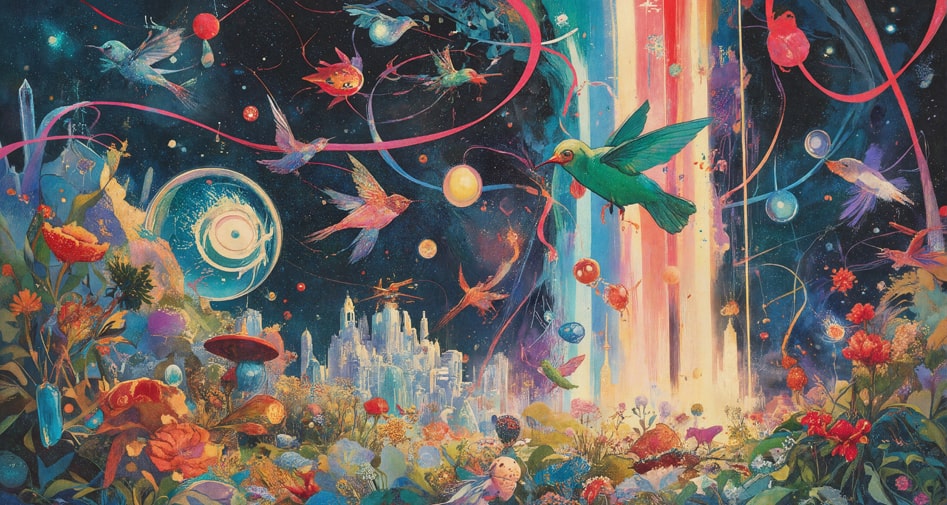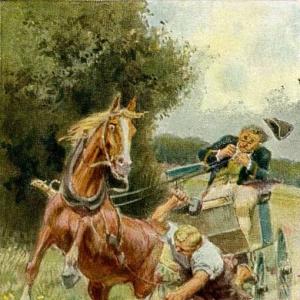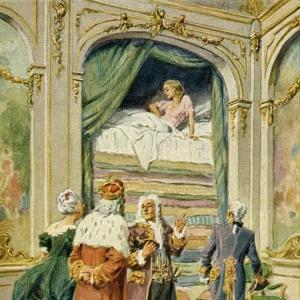Reading time: 19 min
There was once a woman who had three daughters, the eldest of whom was called One-eye, because she had only one eye in the middle of her forehead, and the second, Two-eyes, because she had two eyes like other folks, and the youngest, Three-eyes, because she had three eyes; and her third eye was also in the centre of her forehead. However, as Two-eyes saw just as other human beings did, her sisters and her mother could not endure her. They said to her, „Thou, with thy two eyes, art no better than the common people; thou dost not belong to us!“ They pushed her about, and threw old clothes to her, and gave her nothing to eat but what they left, and did everything that they could to make her unhappy. It came to pass that Two-eyes had to go out into the fields and tend the goat, but she was still quite hungry, because her sisters had given her so little to eat. So she sat down on a ridge and began to weep, and so bitterly that two streams ran down from her eyes. And once when she looked up in her grief, a woman was standing beside her, who said, „Why art thou weeping, little Two-eyes?“ Two-Eyes answered, „Have I not reason to weep, when I have two eyes like other people, and my sisters and mother hate me for it, and push me from one corner to another, throw old clothes at me, and give me nothing to eat but the scraps they leave? To-day they have given me so little that I am still quite hungry.“ Then the wise woman said, „Wipe away thy tears, Two-eyes, and I will tell thee something to stop thee ever suffering from hunger again; just say to thy goat,
„Bleat, my little goat, bleat,
Cover the table with something to eat,“
and then a clean well-spread little table will stand before thee, with the most delicious food upon it of which thou mayst eat as much as thou art inclined for, and when thou hast had enough, and hast no more need of the little table, just say,
„Bleat, bleat, my little goat, I pray,
And take the table quite away,“
and then it will vanish again from thy sight.“ Hereupon the wise woman departed. But Two-eyes thought, „I must instantly make a trial, and see if what she said is true, for I am far too hungry,“ and she said,
„Bleat, my little goat, bleat,
Cover the table with something to eat,“
and scarcely had she spoken the words than a little table, covered with a white cloth, was standing there, and on it was a plate with a knife and fork, and a silver spoon; and the most delicious food was there also, warm and smoking as if it had just come out of the kitchen. Then Two-eyes said the shortest prayer she knew, „Lord God, be with us always, Amen,“ and helped herself to some food, and enjoyed it. And when she was satisfied, she said, as the wise woman had taught her,
„Bleat, bleat, my little goat, I pray,
And take the table quite away,“
and immediately the little table and everything on it was gone again. „That is a delightful way of keeping house!“ thought Two-eyes, and was quite glad and happy.
In the evening, when she went home with her goat, she found a small earthenware dish with some food, which her sisters had set ready for her, but she did not touch it. Next day she again went out with her goat, and left the few bits of broken bread which had been handed to her, lying untouched. The first and second time that she did this, her sisters did not remark it at all, but as it happened every time, they did observe it, and said, „There is something wrong about Two-eyes, she always leaves her food untasted, and she used to eat up everything that was given her. She must have discovered other ways of getting food.“ In order that they might learn the truth, they resolved to send One-eye with Two-eyes when she went to drive her goat to the pasture, to observe what Two-eyes did when she was there, and whether any one brought her anything to eat and drink. So when Two-eyes set out the next time, One-eye went to her and said, „I will go with you to the pasture, and see that the goat is well taken care of, and driven where there is food.“ But Two-eyes knew what was in One-eye’s mind, and drove the goat into high grass and said, „Come, One-eye, we will sit down, and I will sing something to you.“ One-eye sat down and was tired with the unaccustomed walk and the heat of the sun, and Two-eyes sang constantly,
„One eye, wakest thou? One eye, sleepest thou?“
until One-eye shut her one eye, and fell asleep, and as soon as Two-eyes saw that One-eye was fast asleep, and could discover nothing, she said,
„Bleat, my little goat, bleat,
Cover the table with something to eat,“
and seated herself at her table, and ate and drank until she was satisfied, and then she again cried,
„Bleat, bleat, my little goat, I pray,
And take the table quite away,“
and in an instant all was gone. Two-eyes now awakened One-eye, and said, „One-eye, you want to take care of the goat, and go to sleep while you are doing it, and in the meantime the goat might run all over the world. Come, let us go home again.“ So they went home, and again Two-eyes let her little dish stand untouched, and One-eye could not tell her mother why she would not eat it, and to excuse herself said, „I fell asleep when I was out.“
Next day the mother said to Three-eyes, „This time thou shalt go and observe if Two-eyes eats anything when she is out, and if any one fetches her food and drink, for she must eat and drink in secret.“ So Three-eyes went to Two-eyes, and said, „I will go with you and see if the goat is taken proper care of, and driven where there is food.“ But Two-eyes knew what was in Three-eyes‘ mind, and drove the goat into high grass and said, „We will sit down, and I will sing something to you, Three-eyes.“ Three-eyes sat down and was tired with the walk and with the heat of the sun, and Two-eyes began the same song as before, and sang,
„Three eyes, are you waking?“
but then, instead of singing,
„Three eyes, are you sleeping?“
as she ought to have done, she thoughtlessly sang,
„Two eyes, are you sleeping?“
and sang all the time,
„Three eyes, are you waking? Two eyes, are you sleeping?“
Then two of the eyes which Three-eyes had, shut and fell asleep, but the third, as it had not been named in the song, did not sleep. It is true that Three-eyes shut it, but only in her cunning, to pretend it was asleep too, but it blinked, and could see everything very well. And when Two-eyes thought that Three-eyes was fast asleep, she used her little charm,
„Bleat, my little goat, bleat,
Cover the table with something to eat,“
and ate and drank as much as her heart desired, and then ordered the table to go away again,
„Bleat, bleat, my little goat, I pray,
And take the table quite away,“
and Three-eyes had seen everything. Then Two-eyes came to her, waked her and said, „Have you been asleep, Three-eyes? You are a good care-taker! Come, we will go home.“ And when they got home, Two-eyes again did not eat, and Three-eyes said to the mother, „Now, I know why that high-minded thing there does not eat. When she is out, she says to the goat,
„Bleat, my little goat, bleat,
Cover the table with something to eat,“
and then a little table appears before her covered with the best of food, much better than any we have here, and when she has eaten all she wants, she says,
„Bleat, bleat, my little goat, I pray,
And take the table quite away,“
and all disappears. I watched everything closely. She put two of my eyes to sleep by using a certain form of words, but luckily the one in my forehead kept awake.“ Then the envious mother cried, „Dost thou want to fare better than we do? The desire shall pass away,“ and she fetched a butcher’s knife, and thrust it into the heart of the goat, which fell down dead.
When Two-eyes saw that, she went out full of trouble, seated herself on the ridge of grass at the edge of the field, and wept bitter tears. Suddenly the wise woman once more stood by her side, and said, „Two-eyes, why art thou weeping?“ – „Have I not reason to weep?“ she answered. „The goat which covered the table for me every day when I spoke your charm, has been killed by my mother, and now I shall again have to bear hunger and want.“ The wise woman said, „Two-eyes, I will give thee a piece of good advice; ask thy sisters to give thee the entrails of the slaughtered goat, and bury them in the ground in front of the house, and thy fortune will be made.“ Then she vanished, and Two-eyes went home and said to her sisters, „Dear sisters, do give me some part of my goat. I don’t wish for what is good, but give me the entrails.“ Then they laughed and said, „If that’s all you want, you can have it.“ So Two-eyes took the entrails and buried them quietly in the evening, in front of the house-door, as the wise woman had counselled her to do.
Next morning, when they all awoke, and went to the house-door, there stood a strangely magnificent tree with leaves of silver, and fruit of gold hanging among them, so that in all the wide world there was nothing more beautiful or precious. They did not know how the tree could have come there during the night, but Two-eyes saw that it had grown up out of the entrails of the goat, for it was standing on the exact spot where she had buried them. Then the mother said to One-eye, „Climb up, my child, and gather some of the fruit of the tree for us.“ One-eye climbed up, but when she was about to get hold of one of the golden apples, the branch escaped from her hands, and that happened each time, so that she could not pluck a single apple, let her do what she might. Then said the mother, „Three-eyes, do you climb up. You with your three eyes can look about you better than One-eye.“ One-eye slipped down, and Three-eyes climbed up. Three-eyes was not more skilful, and might search as she liked, but the golden apples always escaped her. At length the mother grew impatient, and climbed up herself, but could get hold of the fruit no better than One-eye and Three-eyes, for she always clutched empty air. Then said Two-eyes, „I will just go up, perhaps I may succeed better.“ The sisters cried, „You indeed, with your two eyes, what can you do?“ But Two-eyes climbed up, and the golden apples did get out of her way, but came into her hand of their own accord, so that she could pluck them one after the other, and brought a whole apronful down with her. The mother took them away from her, and instead of treating poor Two-eyes any better for this, she and One-eye and Three-eyes were only envious, because Two-eyes alone had been able to get the fruit, and they treated her still more cruelly.
It so befell that once when they were all standing together by the tree, a young knight came up. „Quick, Two-eyes,“ cried the two sisters, „creep under this, and don’t disgrace us!“ and with all speed they turned an empty barrel which was standing close by the tree over poor Two-eyes, and they pushed the golden apples which she had been gathering, under it too. When the knight came nearer he was a handsome lord, who stopped and admired the magnificent gold and silver tree, and said to the two sisters, „To whom does this fine tree belong? Any one who would bestow one branch of it on me might in return for it ask whatsoever he desired.“ Then One-eye and Three-eyes replied that the tree belonged to them, and that they would give him a branch. They both took great trouble, but they were not able to do it, for the branches and fruit both moved away from them every time. Then said the knight, „It is very strange that the tree should belong to you, and that you should still not be able to break a piece off.“ They again asserted that the tree was their property. Whilst they were saying so, Two-eyes rolled out a couple of golden apples from under the barrel to the feet of the knight, for she was vexed with One-eye and Three-eyes, for not speaking the truth. When the knight saw the apples he was astonished, and asked where they came from. One-eye and Three-eyes answered that they had another sister, who was not allowed to show herself, for she had only two eyes like any common person. The knight, however, desired to see her, and cried, „Two-eyes, come forth.“ Then Two-eyes, quite comforted, came from beneath the barrel, and the knight was surprised at her great beauty, and said, „Thou, Two-eyes, canst certainly break off a branch from the tree for me.“ – „Yes,“ replied Two-eyes, „that I certainly shall be able to do, for the tree belongs to me.“ And she climbed up, and with the greatest ease broke off a branch with beautiful silver leaves and golden fruit, and gave it to the knight. Then said the knight, „Two-eyes, what shall I give thee for it?“ – „Alas!“ answered Two-eyes, „I suffer from hunger and thirst, grief and want, from early morning till late night. If you would take me with you, and deliver me from these things, I should be happy.“ So the knight lifted Two-eyes on to his horse, and took her home with him to his father’s castle, and there he gave her beautiful clothes, and meat and drink to her heart’s content, and as he loved her so much he married her, and the wedding was solemnized with great rejoicing. When Two-eyes was thus carried away by the handsome knight, her two sisters grudged her good fortune in downright earnest. The wonderful tree, however, still remains with us,“ thought they, „and even if we can gather no fruit from it, still every one will stand still and look at it, and come to us and admire it. Who knows what good things may be in store for us?“ But next morning, the tree had vanished, and all their hopes were at an end. And when Two-eyes looked out of the window of her own little room, to her great delight it was standing in front of it, and so it had followed her.
Two-eyes lived a long time in happiness. Once two poor women came to her in her castle, and begged for alms. She looked in their faces, and recognized her sisters, One-eye, and Three-eyes, who had fallen into such poverty that they had to wander about and beg their bread from door to door. Two-eyes, however, made them welcome, and was kind to them, and took care of them, so that they both with all their hearts repented the evil that they had done their sister in their youth.
 Learn languages. Double-tap on a word.Learn languages in context with Childstories.org and Deepl.com.
Learn languages. Double-tap on a word.Learn languages in context with Childstories.org and Deepl.com.Backgrounds
Interpretations
Adaptions
Summary
Linguistics
„One-Eye, Two-Eyes, and Three-Eyes“ is a German fairy tale collected by the Brothers Grimm in their famous book „Grimm’s Fairy Tales“ (also known as „Children’s and Household Tales“ or „Kinder- und Hausmärchen“). The story was first published in 1812 in the first edition of their collection and is listed as tale number 130.
The Brothers Grimm, Jacob and Wilhelm Grimm, were German academics, linguists, and authors who are best known for their work in collecting and publishing folklore during the early 19th century. Their goal was to preserve the oral tradition of Germanic folklore, which they believed was an essential part of their cultural heritage. As a result, they collected and published hundreds of tales, many of which have become classic stories known and loved around the world, such as „Cinderella,“ „Snow White,“ „Rapunzel,“ and „Hansel and Gretel.“
The story of „One-Eye, Two-Eyes, and Three-Eyes“ revolves around a girl named Two-Eyes, who is mistreated by her family for having two eyes, which they consider normal and therefore inferior. Her sisters, One-Eye and Three-Eyes, have one and three eyes, respectively, and believe themselves to be superior. Throughout the story, Two-Eyes faces adversity, learns valuable lessons, and ultimately finds happiness through her kindness, resilience, and the help of a wise woman and a knight. The tale conveys themes of overcoming adversity, the importance of inner beauty and kindness, and the consequences of envy and dishonesty.
The fairy tale „One-Eye, Two-Eyes, and Three-Eyes“ by the Brothers Grimm conveys several themes and interpretations that can be derived from the story. Some of these include.
Overcoming adversity and cruelty: Two-Eyes is mistreated by her mother and sisters because of her perceived „normalcy.“ Despite their cruelty, she remains strong and eventually finds happiness with the help of the wise woman and the knight.
The importance of inner beauty and kindness: Two-Eyes‘ sisters and mother are envious and cruel, whereas Two-Eyes is kind and empathetic. This ultimately leads to her good fortune and happiness, suggesting that inner beauty and kindness are more important than external appearances.
Magic as a means of justice and reward: The wise woman’s magical advice and the enchanted tree help Two-Eyes overcome her difficult situation. This could be interpreted as a metaphor for the power of resilience, resourcefulness, and hope in overcoming challenges.
The consequences of envy and dishonesty: One-Eye and Three-Eyes are envious of Two-Eyes‘ good fortune and try to deceive the knight. Their dishonesty is ultimately revealed, and they do not benefit from the enchanted tree. This serves as a reminder of the negative consequences that can result from envy and dishonesty.
Empowerment and self-reliance: Despite her difficult circumstances, Two-Eyes takes control of her life and creates her own opportunities with the help of the wise woman. This illustrates the importance of self-reliance and empowerment in overcoming adversity.
The fairy tale „One-Eye, Two-Eyes, and Three-Eyes“ from the Brothers Grimm has been adapted and retold in various forms across different cultures and mediums. Some notable adaptations include.
„Three Eyes,“ a children’s book by the American author and illustrator Marcia Brown. Published in 1972, the book retells the story with a modern twist, focusing on themes of self-acceptance and individuality.
„One-Eye, Two-Eyes, and Three-Eyes,“ an episode of the animated television series „Faerie Tale Theater.“ Originally aired in 1982, the episode starred Shelley Duvall as the narrator and featured a star-studded cast, including Kim Basinger and Bud Cort.
„A Very Different Three-Eyed Tale,“ a short film by the Indian animator Gitanjali Rao. Released in 2007, the film retells the story with an Indian twist, featuring a young girl with three eyes who must navigate the pressures of conforming to societal expectations.
„Three Eyes,“ a play by the British playwright Pam Gems. First performed in 1986, the play reimagines the story with a feminist twist, exploring themes of power, gender, and identity.
„Tri-occhio,“ a children’s book by the Italian author and illustrator Gigi Guadagnucci. Published in 2003, the book retells the story with an Italian twist, featuring a young girl with three eyes who must outsmart a greedy witch.
These adaptations showcase the enduring appeal of the story’s themes and characters, and demonstrate the versatility of the original tale.
„One-Eye, Two-Eyes, and Three-Eyes“ is a Brothers Grimm fairy tale about a woman who has three daughters, named according to the number of eyes they have. Two-Eyes, having the normal number of eyes, is treated poorly by her family. One day, she meets a wise woman who teaches her a charm to conjure a magical feast using her goat. When her sisters find out, they grow envious and kill the goat.
Following the wise woman’s advice, Two-Eyes buries the goat’s entrails in the ground, and a magnificent tree with silver leaves and golden fruit grows overnight. The sisters are unable to pluck any fruit from the tree, but Two-Eyes can. A handsome knight comes by, seeking a branch from the tree, and after seeing Two-Eyes‘ ability to pluck the fruit, he takes her away with him.
The knight brings Two-Eyes to his castle, where she is treated well and eventually marries him. Meanwhile, her envious sisters are left with the magical tree, which eventually withers and dies. The sisters are eventually struck blind and deaf as punishment for their cruelty, while Two-Eyes lives happily ever after with her husband.
The Brothers Grimm fairy tale „One-Eye, Two-Eyes, and Three-Eyes“ is a narrative filled with symbolism, motifs, and themes characteristic of fairy tales, with linguistic and structural elements that reinforce its moral and fantastical dimensions.
Character Naming and Symbolism
Names as Descriptors: The names of the characters, One-eye, Two-eyes, and Three-eyes, are literal descriptors that also carry symbolic weight. Two-Eyes, with her „normal“ human characteristic, is ostracized by her family, highlighting themes of normalcy versus difference.
Symbolism in Physical Appearance: The number of eyes each character has symbolizes their perspective or insight. Two-Eyes, despite being the ‚average‘ one, gains true insight and prosperity, perhaps implying the value of seeing the world as it is.
Dialogue and Traditional Formulae
Repetitive Structure: The story makes use of repetition, a common technique in oral storytelling and fairy tales, which aids in memorability and emphasizes key narrative elements, like the charm „Bleat, my little goat, bleat. . . „.
Traditional Phrases: The use of phrases like “Lord God, be with us always, Amen” adds a cultural and religious layer, reflecting the tale’s origins in a Christian cultural context.
Elements of Magic and Transformation
Magical Objects and Spells: The goat and its magical abilities, as well as the transformative magic of the buried entrails, are typical fairy tale elements that symbolize unexpected blessings and the power of faith or kindness.
Transformation Themes: The transition from scarcity to abundance (the magical table) and from oppression to emancipation (Two-Eyes‘ journey) are central to the narrative’s progression.
Themes of Envy and Justice
Envy and Retribution: The sisters’ envy drives the conflict, and natural justice is served as Two-Eyes‘ innate goodness and insight lead her to happiness. This serves as a moral lesson against the dangers of envy and mistreatment.
Reconciliation and Forgiveness: Despite the sisters‘ cruelty, Two-Eyes forgives them later in life, a resolution that embodies the moral high ground and offers a message of forgiveness and redemption.
Narrative Structure
Introduction of Conflict: The story begins with Two-Eyes‘ alienation and mistreatment, setting the stage for conflict and her subsequent quest for a better life.
Rising Action with Magical Intervention: The appearance of the wise woman and the magical goat introduces a turning point, providing Two-Eyes with the means to overcome her plight.
Climax and Resolution: The climax occurs when Two-Eyes successfully wins the knight’s favor, leading to her rescue and marriage. The resolution comes with the reconciliation and the sisters‘ repentance, bringing moral closure.
Social and Cultural Commentary
Class and Social Mobility: Two-Eyes‘ rise from poverty to nobility through marriage to the knight suggests themes of social mobility. Her contentment in the castle contrasts starkly with her earlier life of deprivation.
Family Dynamics and Social Norms: The tale explores family dynamics and societal notions of normalcy, illustrating how those who are different can be marginalized. It critiques these norms by rewarding the unique and virtuous character.
In summary, „One-Eye, Two-Eyes, and Three-Eyes“ employs traditional fairy tale elements, such as repetitive language, magical motifs, and moral lessons, to weave a narrative that explores themes of envy, justice, and the value of inner virtue. It is a rich text for linguistic and cultural analysis, reflective of the societal values and storytelling traditions of the Brothers Grimm era.
Information for scientific analysis
Fairy tale statistics | Value |
|---|---|
| Number | KHM 130 |
| Aarne-Thompson-Uther-Index | ATU Typ 511 |
| Translations | DE, EN, DA, ES, FR, PT, FI, HU, IT, JA, NL, PL, RO, RU, TR, VI, ZH |
| Readability Index by Björnsson | 30.2 |
| Flesch-Reading-Ease Index | 81.8 |
| Flesch–Kincaid Grade-Level | 7.2 |
| Gunning Fog Index | 9.9 |
| Coleman–Liau Index | 7.5 |
| SMOG Index | 7.9 |
| Automated Readability Index | 8 |
| Character Count | 14.255 |
| Letter Count | 10.842 |
| Sentence Count | 127 |
| Word Count | 2.738 |
| Average Words per Sentence | 21,56 |
| Words with more than 6 letters | 237 |
| Percentage of long words | 8.7% |
| Number of Syllables | 3.337 |
| Average Syllables per Word | 1,22 |
| Words with three Syllables | 84 |
| Percentage Words with three Syllables | 3.1% |

 Facebook
Facebook  Whatsapp
Whatsapp  Messenger
Messenger  Telegram
Telegram Reddit
Reddit















